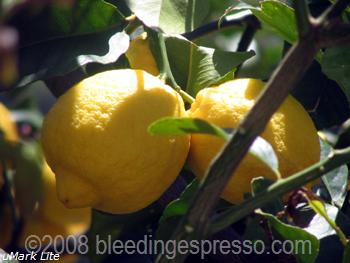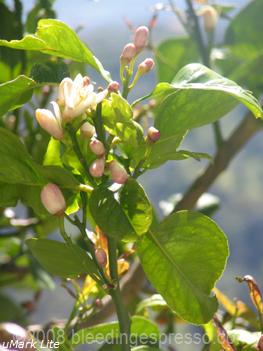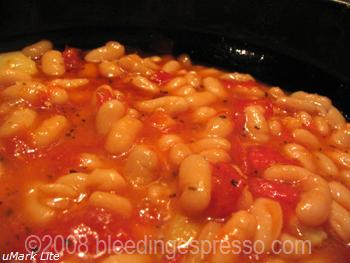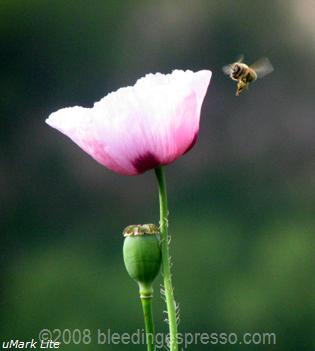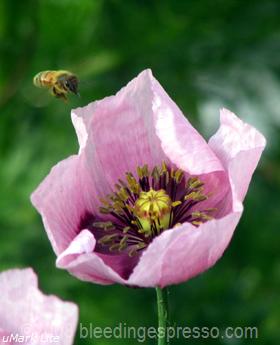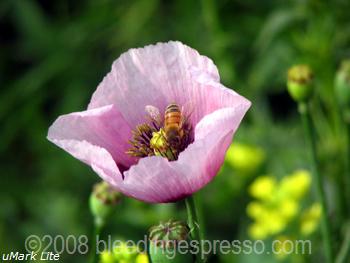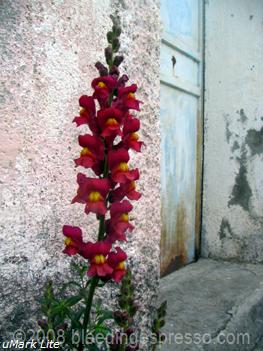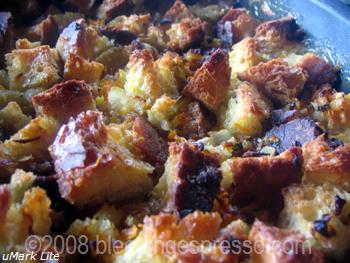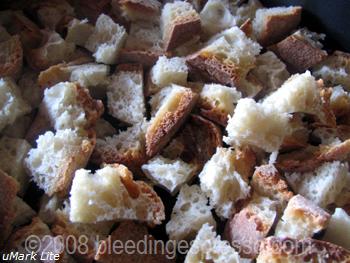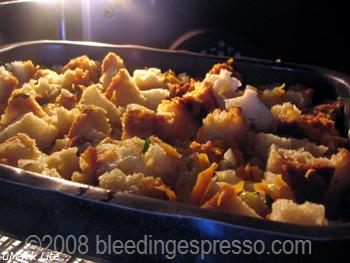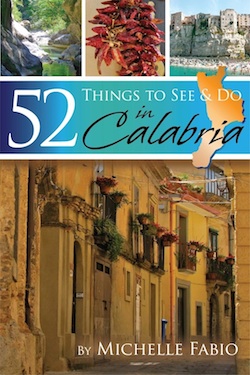Archive for 2008
love thursday: lemon love
I’m celebrating lemon love this week.
Although this wonderful citrus fruit grows year round here, lemons still say l’estate to me. I *love* an ice cold glass of homemade lemonade; P prefers lemon slices sprinkled with salt.
As much as I love to enjoy lemons, though, I couldn’t split up this adorable pair:
Even though I know that more are on their way.
What’s your favorite way to enjoy a lemon?
Happy Love Thursday everyone!
What’s Cooking Wednesday: Cannellini Beans & Tomatoes
 This week’s What’s Cooking Wednesday came about as a “What do we already have in the house?” dish.
This week’s What’s Cooking Wednesday came about as a “What do we already have in the house?” dish.
We had some cannellini beans that P’s mom had prepared for us (they were already soaked and cooked), and although we usually pair them with chicory, we wanted something different.
So I searched the Internet and found this recipe for the traditional Florentine Fagioli all’Uccelletto, which calls for just tomatoes, garlic, olive oil, and sage in addition to the beans. Since I didn’t have any sage, I used basil instead.
And it was delicious.
In fact, this has quickly become a staple for us–so quick and easy, and it sticks to your ribs too, especially when you pair it with fresh bread.
If you want to use dry beans, please see instructions here for soaking and cooking before you add them. I tend to use canned beans because they keep their consistency a little better when mixed with tomatoes in particular.
Cannellini Beans & Tomatoes
- 4 tablespoons olive oil
- 3 medium-sized ripe tomatoes, cut into chunks
- 3 small cloves of garlic, each cut in half
- 1 tablespoon of dry basil or a few leaves of fresh basil (adjust to taste)
- 2 (400 g) cans cannellini beans
- salt to taste
1. In medium saucepan, heat olive oil over medium heat.
2. Add tomatoes, garlic, basil, and a bit of salt, and let cook for about 15-20 minutes, stirring often with a wooden spoon. You essentially want this to become a chunky sauce. Note that if you’re really against tomato skins in this, parboil the tomatoes first and remove the skins before adding them to the pan.
3. Stir in beans and let cook for another 10 minutes or so. Remember that the beans really only need to be heated through, so be sure the tomatoes are cooked to your liking before adding the beans; otherwise you’ll end up cooking the beans too long, and they’ll get mushy.
4. Adjust for salt and serve hot with crusty bread.
Buon appetito!
Earth Day 2008: The Plight of the Honeybee
 Today is Earth Day, 24 hours for us to stop and really think about how our actions affect the environment.
Today is Earth Day, 24 hours for us to stop and really think about how our actions affect the environment.
Of course we should do this every day, but, according to the Earth Day Network website, since 1970, April 22 has represented at least one day per year for people around the world to “celebrate the earth and renew our commitment to building a safer, healthier and cleaner world for all of us.”
The Earth Day Network site offers many ideas as to how you can get involved:
Volunteer. Go to a festival. Install solar panels on your roof. Organize an event where you live. Change a habit. Help launch a community garden.
Communicate your priorities to your elected representatives.
The possibilities are endless! Do something nice for the earth, have fun, meet new people, and make a difference.
This Earth Day, I’m going to tell you about the birds and the bees.
OK, really just the bees, but I wanted to make sure you were paying attention.
The plight of honeybees may seem small in comparison to many of the other problems our environment faces, but make no mistake–the fact that millions of honeybees are dying (Colony Collapse Disorder) can have disastrous effects not only on flowers and honey but also on food production, including many of the fruits we hold so dear.
Honeybees pollinate about a third of the food we eat, and without sufficient numbers of bees, these crops simply can’t survive.
Why are bees dying?
A few reasons:
- stronger pesticides (which, incidentally, can be toxic to humans as well);
- loss of natural habitats due to urban expansion;
- changes in farming techniques that replace native vegetation with pasture grasses for cattle; and
- more frequent severe droughts in some areas like southern Italy
The endangerment of honeybees has been big news in Italy. The National Beekeepers’ Association (UNAAPI) has seen drastic drops in honey production–as much as 50%–because of a silent “slaughter of bees.” Along with southern Italy, Tuscany and Umbria have also been hit hard.
Environmental group Legambiente and the Slow Food movement have teamed up to help the UNAAPI create a buzz about the endangerment of bees; hopefully world leaders and lawmakers will work together to ensure that we all avoid getting stung by a major loss of honeybees.
For more information and what you can do to help, see PBS’s program Endangered Honeybees and Häagen-Dazs’s page on how to Help the Honey Bees.
of snapdragons and lion’s mouths
Before I moved to Italy, I was never good at remembering and identifying flowers and trees. No matter how many times someone told me “this is a peony and that’s a petunia,” the information just didn’t stick in my brain–like it just wasn’t wired that way.
Thankfully things have since changed, and I find my memory working in perfect harmony with nature. I am always happy to learn a new leaf shape, a new flower, and have it stick in my head without much effort especially since I am surrounded by plenty of flowers I’ve never seen before (not that I remember anyway).
For weeks I had been meaning to photograph some interesting flowers that I pass on my walk with the dogs. I finally grabbed the camera the other day, afraid that the magenta petals would shrivel up before I had a chance to immortalize them.
For some reason, I kept thinking: “I *know* my mom would know what these are” but how could I describe them over the phone?
So I came home and put the photos up on Flickr, and asked if anyone knew what they were called. My new friend Doisemum kindly responded with a link in Italian telling me that these are Bocca di Leone (lion’s mouth) in Italian.
P had actually told me they were called something that starts with a B and ends in “leone” so he was on the right track. Then I searched for the name in English and found out that these are Snapdragons.
Immediately I thought, “My mom loves snapdragons!”
Only I had no idea why I thought that. No specific memory in which my mom talked about snapdragons came to mind, but I just had this overwhelming feeling that I had to tell her about these flowers.
Later that evening, I walked with the pooches again and couldn’t believe what I saw–the very same flowers that I had photographed hours before had been pulled up from the roots and left to rot on the pavement!
I guess someone thought they were weeds (mind you no one lives where these flowers grow) and decided to do his/her civic duty–and then let them sit there in small piles on the ground, as if that looked prettier.
Good thing I had taken the photos in the morning, I thought, and gathered up the long stems, brought them home, and stuck them in some water in a jar on my fireplace, hoping to extend their life just a bit longer:
Later I told my mom about the whole strange experience–and her reaction when I told her I found out what “those” flowers” were?
“I love snapdragons!”
Turns out that she has very fond memories of playing with these as a child, making their “mouths” open up and talk.
It is an understatement to say that my mom doesn’t have many fond memories from childhood, so this was extra-special for her to relive and also for me to hear.
I can only conclude that she must have told me about this somewhere along the way and that my brain kept just enough information handy for someday when I could truly appreciate the Story of the Snapdragons–for when it was rewired to handle it.
And now I will always remember what snapdragons look like and why it’s important that I stop and make them talk.
La Buona Cucina Americana: Thanksgiving Filling
 Or stuffing or dressing depending on where you’re from.
Or stuffing or dressing depending on where you’re from.
Thanksgiving is absolutely my favorite holiday. It’s all about giving thanks and eating–two of my favorite things. And while I *like* turkey, for me the stars of Thanksgiving are the side dishes. Love them.
I love my mom’s filling the most–so much that it is my first contribution to La Buona Cucina Americana.
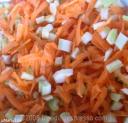 If you don’t know what this is, read Judith in Umbria’s description here.
If you don’t know what this is, read Judith in Umbria’s description here.
Essentially we Americans are tired of the trash-talking (pun intended) about our cuisine. Contrary to popular stereotypes (often involving Golden Arches), Americans do shop at markets, slice and dice fresh ingredients, and otherwise make real homemade meals.
Through La Buona Cucina Americana, we are sharing some of our favorite recipes in English and Italian so our Italian amici can try them out too.
So far we’ve had:
- Mary’s American Style Shepherd Pie
- Judith’s Chicken Pot Pie
- Barb’s Scalloped Potatoes
- Sara’s Barbecue Baked Beans
And now, straight from my mom’s cucina:
Thanksgiving Filling
- 1 stick of butter
- 3 carrots, peeled and shredded
- 3 celery stalks, chopped finely
- 1 large onion, chopped finely
- handful of parsley, chopped finely
- 1 loaf stale bread, in chunks (sliced bread is fine)
- 2 cups chicken or vegetable broth
1. Preheat oven to 350°F.
2. Melt butter in large pan and add carrots, celery, onion, and parsley. Sauté for about 10 minutes.
3. In the meantime, make sure the water and broth are heated and grease a medium-sized baking dish with butter.
4. When carrots, celery, and onion are soft, pour water and broth into pan.
5. Add bread cubes, which should look something like this:
6. Mix with wooden spoon until all bread is moistened, but don’t overmix.
7. Pour mixture into baking dish, and bake in oven for about an hour, a little longer to get an even crunchier top.
8. Let sit for about five minutes after you take it out of the oven before serving.
Notes:
- I bake mine in the oven because I like an uber-crunchy top, but you can also use this as a traditional “stuffing” by stuffing this inside the bird of your choice; just let it cool off before you do so.
- Some of you may be wondering where the sausage is. My mom doesn’t make hers with sausage, so I don’t either. P–like a true Calabrian–asked if I would include it next time, and I will because I’m a good fidanzata.
Ripieno tradizionale per tacchino per il giorno di Ringraziamento
- 110 g di burro
- 3 carote pelate e grattugiate
- 3 gambi di sedano tritati
- 1 cipolla (bianca o gialla) grande tritata
- prezzemolo tritato q.b.
- 600 g di pane secco a cubetti
- 250 mL di brodo (vegetale o pollo)
1. Preriscaldare il forno a 180°C.
2. Fate squagliare il burro in una padella grande e aggiungete le carote, il sedano, la cipolla, ed il prezzemolo. Fate appassire per una decina di minuti.
3. Nel frattempo, assicuratevi che l’acqua ed il brodo sono caldi e imburrare la casseruola.
4. Quando le carote, il sedano, e la cipolla diventeranno morbidi, aggiungete l’acqua ed il brodo.
5. Aggiungete i cubetti di pane.
6. Mescolate con un cucchiaio di legno solo fino ad umidire il pane ma non troppo.
7. Versate il composto nella casseruola. Infornate per circa un’ora, qualche minuti in più per una crosta più croccante.
8. Fate riposarlo per circa 5 minuti prima di servirlo.
Annotazioni:
- Io lo cucino al forno perché mi piace una crosta croccantissima ma potete usare il composto anche come un ripieno tradizionale. Lasciatelo raffredare, quindi usatelo per riempire un tacchino, un pollo, ecc.
- Forse state cercando la salsiccia nella ricetta. Mia mamma non la usa quindi non la uso neach’io. Il mio fidanzato P–come un vero Calabrese–mi ha chiesto di aggiungerla e la prossima volta lo farò perché sono una brava fidanzata.
Buon appetito!

